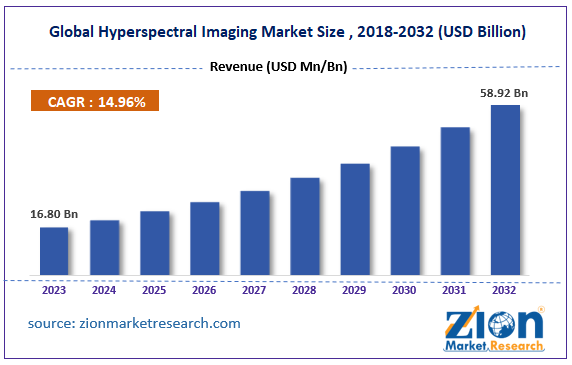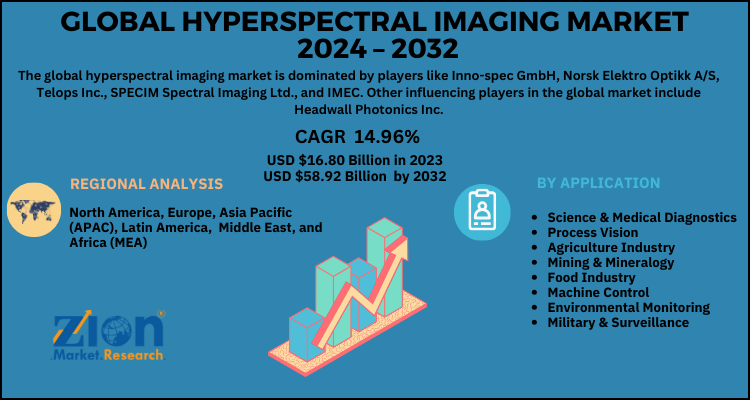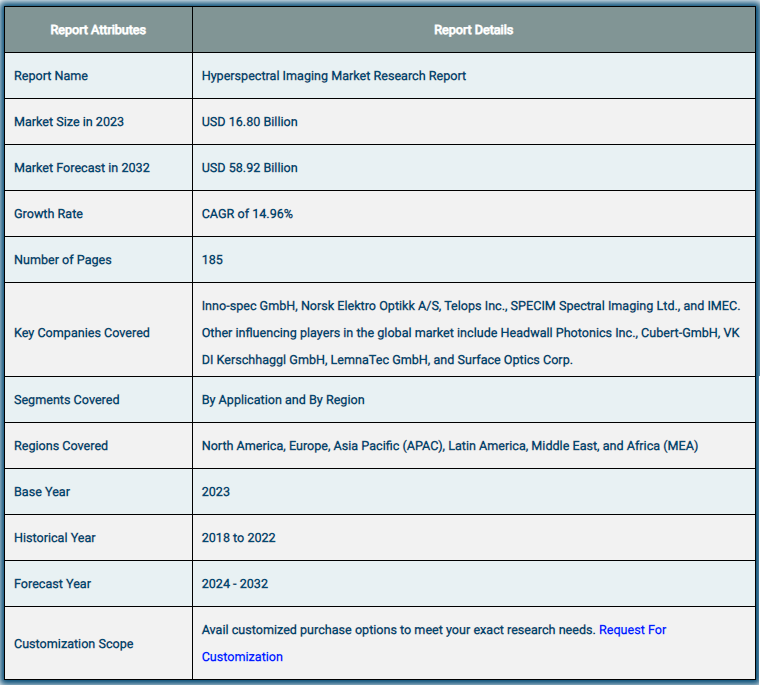Hyperspectral Imaging Market Size, Share, Growth Report 2032

The global hyperspectral imaging market is expected to grow from its estimated value of USD 16.80 billion in 2023 to USD 58.92 billion by the end of 2032, according to a report released by Zion Market Research. Over the course of the projection period, the market is anticipated to expand at a CAGR of 14.96%. The growth factors, barriers, and effects on demand for the worldwide hyperspectral imaging market are examined in this study over the duration of the forecast. It will also assist in navigating and investigating the prospects that present themselves in the hyperspectral imaging market.
✈👉Get a Free Sample: 🚀https://www.zionmarketresearch.com/sample/hyperspectral-imaging-market
Introduction:
- Overview of Hyperspectral Imaging:
Introduce hyperspectral imaging as an advanced imaging technique that captures a wide spectrum of light for each pixel in an image. Unlike traditional imaging methods, hyperspectral imaging provides detailed spectral information, enabling enhanced analysis across various applications, including agriculture, healthcare, environmental monitoring, and security. - Importance of the Market:
Highlight the significance of the hyperspectral imaging market, driven by its ability to provide critical information that supports decision-making in various fields, improves operational efficiency, and fosters innovation.
Overview of the Global Hyperspectral Imaging Market
Hyperspectral imaging is the imaging method that uses the electromagnetic spectrum to gather and process data. This imaging technique’s primary goal is to generate a spectrum for every pixel in the image so that objects can be studied. Hyperspectral imaging is utilized in agricultural development, food contamination identification and detection, and retinopathy diagnosis. In fields of study like nanotoxicology and nanodrug delivery, it is crucial. Applications for hyperspectral imaging are numerous and include defense, science & diagnostics, and agriculture.
An imaging spectrometer is the tool used to create hyperspectral images. In addition to two spatial dimensions and one spectral dimension, the image is created at many wavelengths and generates a three-dimensional hyperspectral data cube. It can measure electromagnetic radiation absorption, reflection, and emission; each pixel is assigned a distinct spectral signature. It is not necessary to have prior knowledge of the sample and to learn the whole spectrum all at once. Hyperspectral imaging offers comprehensive information for image analysis and is helpful in image-guided surgery and illness diagnosis.

Growth Factors for the Global Hyperspectral Imaging Market
The worldwide hyperspectral imaging market may see new development prospects as a result of technological advancements. Major corporations have embraced a number of important tactics, including expansions, partnerships, joint ventures, mergers and acquisitions, and others. The global hyperspectral imaging market is expected to rise as a result of rising healthcare spending and an increase in research projects.
Furthermore, growing government support for research initiatives and the use of hyperspectral imaging in environmental testing could have a beneficial effect on the expansion of the worldwide market. The gastrointestinal tract, mucosal membrane analysis, surface tissue, ophthalmology, and vascular system are the main areas where hyperspectral imaging is chosen, and these factors could drive future growth in the global hyperspectral imaging market. On the other hand, problems with reimbursement, the need for large investments, and the expense of installation could impede the expansion of the worldwide hyperspectral imaging market.
Segmentation of the Global Hyperspectral Imaging Market
The product, technology, application, and geographic segments of the worldwide hyperspectral imaging market are identified.

Product-Based Segmentation Analysis
The worldwide hyperspectral imaging market is segmented into accessories and cameras based on product. A wide range of parts and add-ons that supplement and improve the performance of hyperspectral cameras are included in the accessories sector of the hyperspectral imaging market. These add-ons might be anything from software for data processing and analysis to lighting systems, lenses, and filters. The requirement for complete, customized hyperspectral imaging solutions for a range of applications is driving the market for accessories. With the help of these add-ons, users can tailor their imaging systems to individual needs, whether they industrial inspection, scientific research, agricultural, or environmental monitoring. It is anticipated that the accessories market will expand steadily.
The camera category is the largest, contributing over 72.6% of the market’s total revenue in 2023. The main offering in the hyperspectral imaging market is the hyperspectral camera segment, which can record and process data over a broad range of light wavelengths. For applications that demand more precise spectrum information than conventional imaging systems can offer, these cameras are indispensable. The market for hyperspectral cameras is being pushed by the growing need across a range of industries for improved imaging solutions. Hyperspectral cameras are used in medicine for image-guided surgery and diagnosis.
Technology-Based Segmentation Analysis
The worldwide hyperspectral imaging market is divided into push broom, snapshot, and other segments based on technology. Push broom segment, sometimes referred to as line-scan imaging, is a technique where an entire image is captured one line at a time by moving the sensor or the object. Because of its great spectral and spatial resolution, this approach is widely employed in industrial inspection and remote sensing. Push broom hyperspectral imaging systems are perfect for use in mining, forestry, agriculture, and environmental monitoring because of their exceptional efficiency in catching fine details over wide regions. Push broom technology is highly sought after in these industries due to its capacity to provide images with high resolution and low motion artifacts.
Strong growth is anticipated for the snapshot segment. This segment eliminates the requirement for scanning by capturing the whole hyperspectral cube in a single shot. This technology is especially helpful for applications that need to acquire and analyze data quickly. Because they can quickly record real-time data, snapshot hyperspectral imaging systems are becoming more and more popular in security, food quality inspection, and medical diagnostic applications. For biological imaging and real-time monitoring applications, snapshot systems are perfect because of their rapid data collecting capability, which is especially important for dynamic or fast-moving subjects.
Application-Specific Segmentation Analysis
The worldwide hyperspectral imaging market is divided into several segments based on application, including machine vision, remote sensing, medical diagnostics, military & surveillance, and others. From 2024 to 2032, the medical diagnostics market is expected to develop at a compound annual growth rate (CAGR) of 12.7%. In order to identify illnesses and anomalies, hyperspectral imaging in medical diagnostics collects and analyzes spectral data from tissues and organs. With the aid of this technology, precise diagnosis, early disease identification, and treatment efficacy monitoring are all made possible by comprehensive spectrum information. Hyperspectral imaging’s capacity to offer a non-invasive, incredibly thorough examination of biological tissues is what motivates its application in medical diagnostics. It is especially helpful in the detection of retinal illnesses, the identification of malignant cells, and the monitoring of skin ailments. The use of hyperspectral imaging in healthcare is being driven primarily by the rising incidence of chronic illnesses and the growing need for sophisticated diagnostic instruments.
In the remote sensing portion of hyperspectral imaging, spectral data from the Earth’s surface is collected in order to track and examine environmental conditions. The fields of forestry, geology, agriculture, and environmental monitoring all make substantial use of this technique. Important information on soil composition, water quality, mineral exploration, and vegetation health can be gained via hyperspectral imaging. Accurate and thorough environmental assessments are made possible by the capacity to record and process a broad spectrum of wavelengths. Hyperspectral imaging in remote sensing is becoming more and more necessary due to the growing demands of environmental protection, natural resource management, and sustainable agriculture methods.
Hyperspectral imaging is utilized in the machine vision segment to examine and evaluate materials and products during industrial processes. This technology aids in defect detection, maintains quality control, and boosts production productivity. The necessity for high-precision inspection and quality control in sectors like manufacturing, food processing, and pharmaceuticals is what motivates the usage of hyperspectral imaging in machine vision. The quality and safety of production are improved by the capacity to recognize minute variations in materials and to spot impurities or flaws. The need for high-quality products and the growing automation of industrial processes are the main factors driving this market.
In 2023, the military and surveillance sector constituted 32.4% of the income share. In order to provide precise spectrum data for target identification, threat detection, and reconnaissance, hyperspectral imaging is employed in both military and surveillance applications. With the use of their spectral signatures, this technique offers improved item and material identification capabilities. The requirement for cutting-edge imaging technologies that provide high resolution and accuracy in detecting and identifying threats is what is driving the development of hyperspectral imaging in the military and surveillance. In defense operations, the capacity to obtain comprehensive spectrum data facilitates decision-making and improves situational awareness.
✈👉Directly Purchase a copy of the report with TOC: 🚀https://www.zionmarketresearch.com/toc/hyperspectral-imaging-market
Market for Hyperspectral Imaging: Report Scope

Regional Analysis of the Global Hyperspectral Imaging Market
North America is the global leader in the surge of hyperspectral imaging research activity. Additionally, the growing use of hyperspectral imaging in mining, military surveillance, life sciences and diagnostics, and other fields could promote global market expansion in this area. Global market growth is positively impacted by rising healthcare awareness as well as mining exploration and research activities in North America. Because China and India have the fastest-growing markets, Asia Pacific is expected to grow at a higher rate in the coming years. Furthermore, the biggest market share may be explained by the presence of a sizable patient pool and the developing pharmaceutical industry in Asia Pacific. The Asia Pacific region’s share of the global hyperspectral imaging market is also expanding due to technological developments and the growing use of hyperspectral imaging for research purposes.
Market Drivers:
- Growing Demand for Remote Sensing Applications:
The increasing use of hyperspectral imaging in remote sensing applications, such as land use mapping, mineral exploration, and environmental monitoring, is driving market growth. - Advancements in Technology:
Ongoing technological developments in sensor design, data processing algorithms, and machine learning are enhancing the capabilities and accessibility of hyperspectral imaging systems. - Rising Adoption in Healthcare:
The growing use of hyperspectral imaging for non-invasive diagnostics, tissue characterization, and monitoring of diseases is expanding its application in the healthcare sector. - Increased Investment in Research and Development:
Significant investments in R&D for hyperspectral imaging technologies are leading to innovations and improvements, thereby expanding their application areas.
Market Restraints:
- High Cost of Hyperspectral Imaging Systems:
The high initial investment and operational costs of hyperspectral imaging equipment can be a barrier for smaller companies and organizations, limiting market adoption. - Complexity of Data Interpretation:
The large volumes of data generated by hyperspectral imaging require advanced analytical skills and software, which may limit its adoption among end-users lacking expertise. - Limited Awareness and Understanding:
Lack of awareness about the capabilities and benefits of hyperspectral imaging in various industries can hinder market growth.
Market Segmentation:
- By Product Type:
- Hyperspectral Cameras: Devices that capture hyperspectral images across a wide range of wavelengths.
- Hyperspectral Imaging Systems: Complete systems that include cameras, software, and other components for data analysis.
- By Technology:
- Aerial Imaging: Used in applications like agriculture, forestry, and environmental monitoring, capturing images from drones or aircraft.
- Ground-Based Imaging: Involves capturing hyperspectral images at ground level for applications like healthcare and industrial inspection.
- By Application:
- Agriculture: Crop health monitoring, precision farming, and soil analysis.
- Healthcare: Non-invasive diagnostics, tissue analysis, and surgical guidance.
- Environmental Monitoring: Pollution detection, land cover classification, and habitat mapping.
- Security and Defense: Surveillance, threat detection, and reconnaissance.
- By End-User:
- Government and Defense: Utilization in surveillance and reconnaissance missions.
- Healthcare Providers: Hospitals and diagnostic laboratories adopting hyperspectral imaging for medical applications.
- Agricultural Sector: Farmers and agricultural researchers leveraging hyperspectral data for improved crop management.
- Industrial Sector: Manufacturing and quality control applications.
Regional Insights:
- North America:
The largest market, driven by advanced technology adoption, strong R&D investment, and significant applications in defense and healthcare. - Europe:
A growing market fueled by increasing government initiatives for environmental monitoring and advancements in agricultural practices. Countries like Germany and the U.K. lead in market growth. - Asia-Pacific:
The fastest-growing region due to rising investments in agricultural technology, healthcare advancements, and growing awareness of remote sensing applications in countries like China and India. - Rest of the World (RoW):
Analyze market potential in regions like Latin America, the Middle East, and Africa, where agricultural development and environmental monitoring are gaining importance.
Competitive Landscape:
- Key Players:
Discuss leading companies in the hyperspectral imaging market, such as Headwall Photonics, Specim, Malvern Panalytical, and others. Highlight their product portfolios, market strategies, and recent developments. - Technological Innovations and Collaborations:
Emphasize recent product launches, partnerships, and collaborative efforts among manufacturers, research institutions, and end-users to drive technological advancements.
Future Outlook and Trends:
- Integration of Artificial Intelligence:
The incorporation of AI and machine learning into hyperspectral imaging systems will enhance data analysis and interpretation, leading to more accurate results and faster decision-making. - Growing Adoption in Emerging Economies:
Increased investments in agriculture and healthcare in developing regions are expected to drive demand for hyperspectral imaging solutions. - Expansion of Application Areas:
Hyperspectral imaging is likely to find new applications in areas like food safety, pharmaceuticals, and smart cities, broadening its market potential. - Focus on Miniaturization and Portability:
The development of compact and portable hyperspectral imaging devices will enhance accessibility and usability in various fields, particularly in fieldwork and point-of-care settings.
Conclusion:
Summarize the key trends and growth opportunities in the hyperspectral imaging market, emphasizing the drivers such as technological advancements, rising demand across various applications, and increasing investments in research and development. Highlight the future potential for growth in emerging markets and the importance of addressing challenges related to cost and data interpretation.
✈👉Enquiry for buying: 🚀https://www.zionmarketresearch.com/inquiry/hyperspectral-imaging-market
get to know better
Cervical Dysplasia Treatment Market
Unmanned Aircraft Systems Market
Contact Us:
Zion Market Research212
USA/Canada Toll Free: 1 (855) 465–4651
Newark: 1 (302) 444–016611\
Web: https://www.zionmarketresearch.com/
Blog: https://zmrblog.com/
Comments
Post a Comment